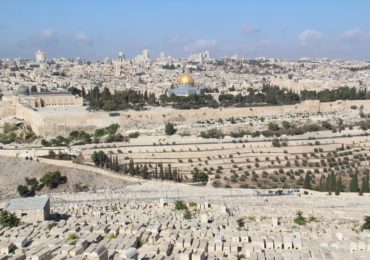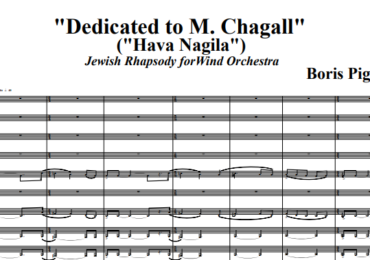

Related posts

Jerusalem
- Duration: ca. 17 minutes
- SO: Picc, 2 Fls, 2 Obs, 2 Cls, B.Cl, 2 Bsns, C.Bsn, 4 Hns, 3 Tpts, 3 Tbns, Tba, Timp, Perc, Hp, Cel, Str.
- SWB: Picc, 2 Fls, Ob, Bsn, 3 Cls, B.Cl, 2 A.Sxs, T.Sx, B.Sx, 4 Hns, 5 Tpts, 4 Tbns, Bar, 2 Tbas, Harp, Str.B, Synth, Timp, Perc
The inspiration behind this work is a city at the centre of three religions – Judaism, Christianity and Islam, City whose name means “peace”, and whose fate is war, City which has known pain and joy, destruction and renewal, sadness and hope, City whose past is submerged in blood. As for its future… Would anybody dare to say that he knows it?
The poem Jerusalem exists in three versions: for solo piano, for symphonic wind band, and for symphony orchestra.
I wrote the piano version in 1991, and revised it in 2002 and in 2009.
Below is a recording of the 2002 version, performed by Michael Zelevinsky in Jerusalem.
The final piano version premiered in 2014 in Paris, at the first COMPETITION-FESTIVAL – modern piano repertoire, performed by Olivier Seuzaret.
Jerusalem for Piano was published in 2015 by Le CHANT du MONDE, Editions Musicales (in France).
In 2017, this work was performed several times by Albanian pianist Almira Emiri. Below is a recording from YouTube.
In 2012, I wrote the symphonic wind band version.
It was premiered in 2013 by the Petach-Tikva Conservatoire Wind Orchestra, conducted by Michael Delman.
Below is an audio recording of that performance. Although both the orchestra and the recording are not professional, the performance was very enthusiastic and presents a favorable rendition the work.
I wrote the initial version for symphony orchestra in 1993, shortly after I wrote the piano version. However, I was not satisfied with the result; I’ve added a lot of additional content to orchestral version, and the combination resulted in a musical structure that lacked cohesion.
After I wrote Holocaust Requiem in 1994-1995, my attitude towards orchestration changed. As result,I put aside Jerusalem until autumn 2017, when I prepared a new version.
Below are recordings of the piano solo version and of the symphonic wind band version.
Piano Solo version
Symphonic Wind Band version

“Dedicated to Marc Chagall” (“Hava Nagila”)
Jewish Rhapsody for Wind Orchestra / String Orchestra (with Optional Piano) / Brass Ensemble / Saxophone Quartet / Solo Bayan
- Duration: ca. 9 minutes
My work Dedicated to Marc Chagall is based on the popular Jewish song Hava Nagila, which means Let us rejoice.
I had originally intended to write a rhapsody based on Hava Nagila, but I found myself writing episodes that were not derived from Hava Nagila. Suddenly, I realized that I was actually composing a tone poem, evoking scenes of a small Jewish town at the beginning of the 20th century. Such images and moods typify novels by Shalom Aleichem and the earlier paintings by Marc Chagall. I felt a particularly strong association to Chagall’s pictures. For this reason, I named the piece Dedicated to Marc Chagall, in addition to the secondary title of Jewish Rhapsody “Hava Nagila”.
I composed the piece in 2003, for wind orchestra, and then for string orchestra (with optional piano). The main part of both versions is similar, but the nature of strings required a completely different introduction for the string version.
The wind orchestra version premiered in 2003, performed by the Petach-Tikva Conservatoire Symphonic Band at Festival Kfar-Saba (in Israel), and conducted by Michael Delman.
The premiere of the string-orchestra was in 2005, performed by the Ramat Gan Chamber Orchestra (in Israel), and conducted by Aviv Ron.
Later, both versions were performed many times in Israel and around the world.
In 2015, the wind-orchestra version was also performed at the WASBE Conference in San Jose, California, by the Israel Youth Wind Orchestra, conducted by Motti Miron. Unfortunately, I don’t have a recording of that performance. However, below is the recording of a different performance of theirs, in Israel, in 2012:
In 2005, I was contacted by the Brandt-Brass Ensemble from Saratov, Russia. They sough a challenging piece to perform for international competition, and I prepared for them a version of Dedicated to Marc Chagall for brass ensemble.
In 2015, I also prepared a version for saxophone quartet; below is recording of that version performed by the Mestizo Saxophone Quartet, in 2018:
In 2012, I received an unexpected application from Ukrainian accordionist Pavel Fenyuk, asking for my permission to write an arrangement of the piece for solo bayan (chromatic button accordion). Below, is his virtuoso performance of that version:
The piece has already seen many variations, and who knows where else it will go?